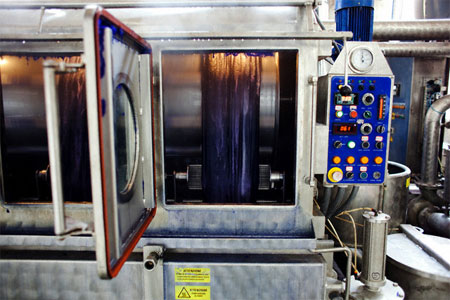By
Reuters
Reuters
Published
Sep 23, 2010
Sep 23, 2010
Wal-Mart and H&M green up their act
By
Reuters
Reuters
Published
Sep 23, 2010
Sep 23, 2010
September 23 2010 - People say you can tell the latest color trends in fashion by looking at the shade of the rivers in China. Each season's dyes get dumped into Chinese waterways after they are circulated through poorly operated textile mills, leaving a string of hazardous chemicals in their wake.
 Fabric is dyed in a machine at the Tiansheng Textile Factory in Shaoxing, Zhejiang Province, China. Photo : Corbis |
There are cleaner, more cost-effective ways to produce textiles, but many factories -- particularly the smaller and older mills -- stick with the status quo until their customers demand sustainable practices.
Yesterday, Wal-Mart agreed to give their suppliers that added push. At the Clinton Global Initiative, the retail giant announced it would work with Chinese textile manufacturers to embrace better industry techniques.
NRDC will be helping guide this process through our Clean by Design program, which has identified 10 simple, low-cost practices that dramatically cut water, energy, and chemical use in textile dyeing and finishing.
The Wal-Mart announcement comes on the heels of similar initiative NRDC launched with H&M several days ago in Shanghai. This means two of the world's largest clothing retailers are committing to clean up one of the biggest sources of industrial water pollution in the world.
Few Americans realize what textile manufacturing entails, but it can be very dirty business. Dyeing and finishing fabrics can pollute as much as 200 tons of water per ton of fabric. The process also consumes an enormous amount of energy for steam and hot water.
Now that the industry is centered in China, India, Bangladesh, and Vietnam where government are still developing environmental regulations -- the industry has a huge environmental footprint.
I went on a tour of textile factory in China a few years ago. Our visit was scheduled in advance, but when we arrived, the facility had been shut down. We walked through the mill and saw the giant dying equipment, but they didn't give us a chance to see it in operation.
My colleague wandered off to the edge of the plant and struck up a conversation with a woman who lived nearby. She said the plant leached so many chemicals into her backyard that she had stopped going outside.
Fortunately some factories are beginning to see the value in cleaner practices. The 10 techniques that NRDC has identified can actually save factories money. Reusing cooling water, for instance, requires an initial cost of $1,500, but that investment is recouped in just one month. The Redbud textile factory in Changshu China -- also a Wal-Mart supplier -- reaps nearly $840,000 in annual savings with upfront costs of only $74,000.
Just a few weeks ago, NRDC's Executive Director Peter Lehner traveled to two Chinese textile factories participating in the Clean by Design program. When Peter asked the CEOs what it would take to get more nearby mills to embrace these cleaner industry practices, they both answered: "More name brands."
Big names like Wal-Mart and H&M have the purchasing power to drive improvements all the way up the supply chain. They send a signal to manufacturers that there is a market out there for textiles made using cleaner practices.
By Frances Beinecke
Source: Greenbiz.com
© Thomson Reuters 2024 All rights reserved.

























